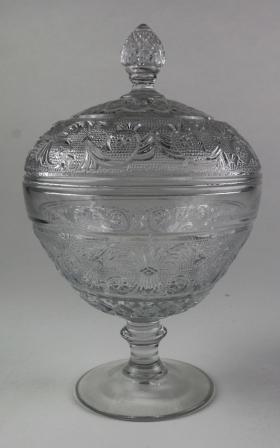
Early American Pattern Glass - known as EAPG by its fans and the trade - has long been a staple of the collectibles world, but properly identifying a given piece of glass can tax even the experts. If you are a dealer looking for help with glass patterns, you might want to call on DoRi Miles, Pattern Glass Editor at EAPGPatterns.com.
Interest in the glass seems to continue strong based on the number of websites and articles related to it. For example, we found patternglass.com which provides educational material in addition to its main fare of pattern glass. There is also the Early American Pattern Glass Society which offers educational materials as well as a pattern identification database. At a local antiques shop in Roswell, GA, a large sign hung advertising one of the EAPG societies.
Pattern glass, also known a pressed glass, is glass made from molds having designs which were applied to a range of objects forming an extended set of table wares, though certainly other classes of glass were made. Serving wares such as pitchers, and dining wares such as drinking glasses were made profusely and in a dizzying number of patterns during the EAPG heyday. Some estimates place the number of designs around 3000.
I think of the EAPG industry as the American Staffordshire. Certainly glass is not ceramics, but just as Staffordshire was a uniquely British phenomenon with myriad producers, most long forgotten, so America had its large skein of pressed glass producers with some concentrations in Indiana, Ohio, New Jersey, and West Virginia. If you are speaking of "period" pattern glass, then you talking about glass made between circa 1850-1910. And to be clear, it is normally non-leaded glass which kept it inexpensive.
But when it comes back to selling glass, people want to know with what pattern they are dealing so that they can acquire more, or intelligently sell what they have. Adding to the large number of patterns is a diversity of colors, though one generally thinks of EAPG as clear - though this is by no means solely the case.
I had the fortunate occasion to stumble upon Ms. Miles, or perhaps I should say that she stumbled upon me, offering to correct mistakes I had in my listings of glass. She has been a dealer, author, and consultant on EAPG longer than some of us have been alive, and proved invaluable in helping me with identification. She saved me considerable time from pouring over mounds of images in databases, and well worth her reasonable fees.
Pattern glass is not dead, and it is not impossible to identify your pattern. Give DoRi a chance if you are stuck.